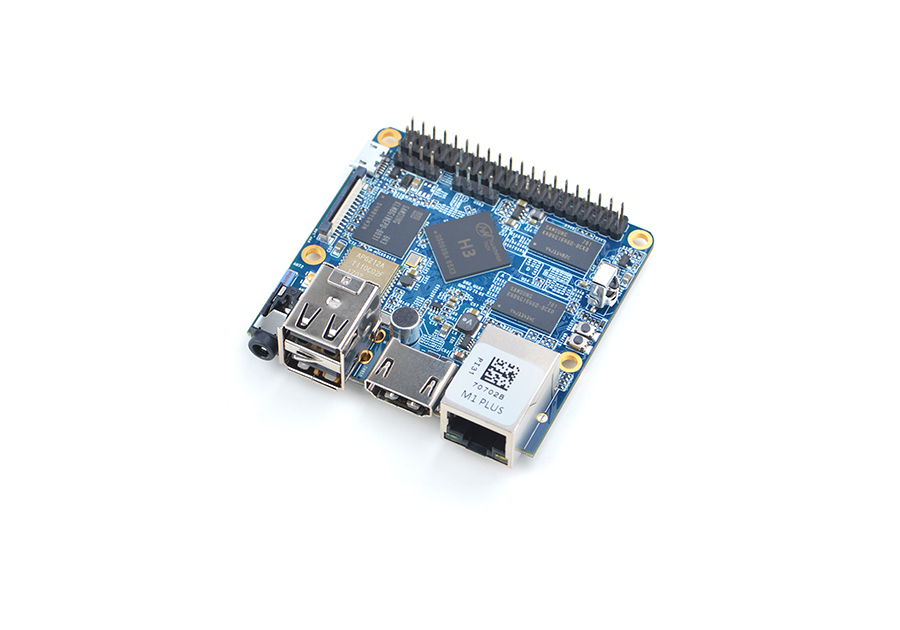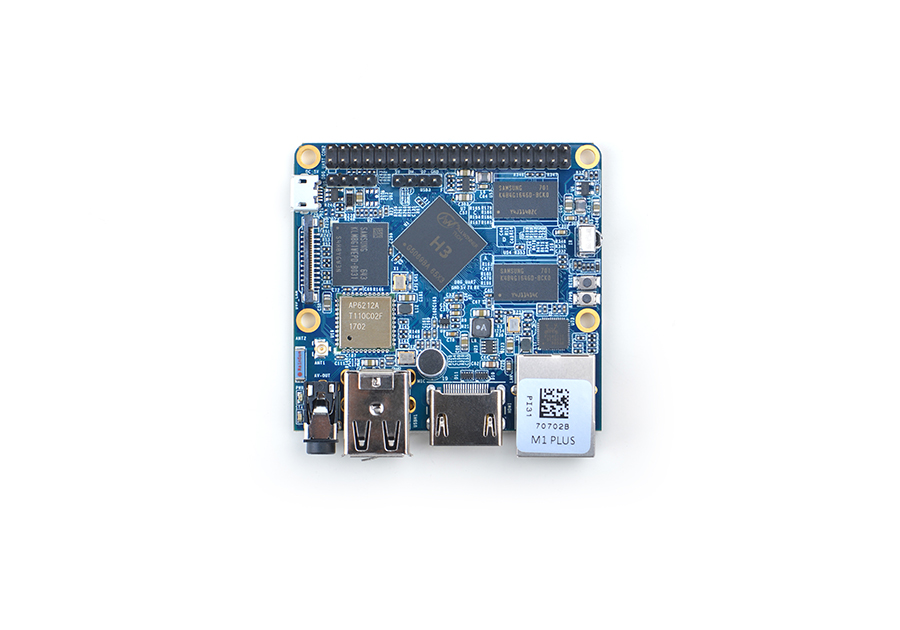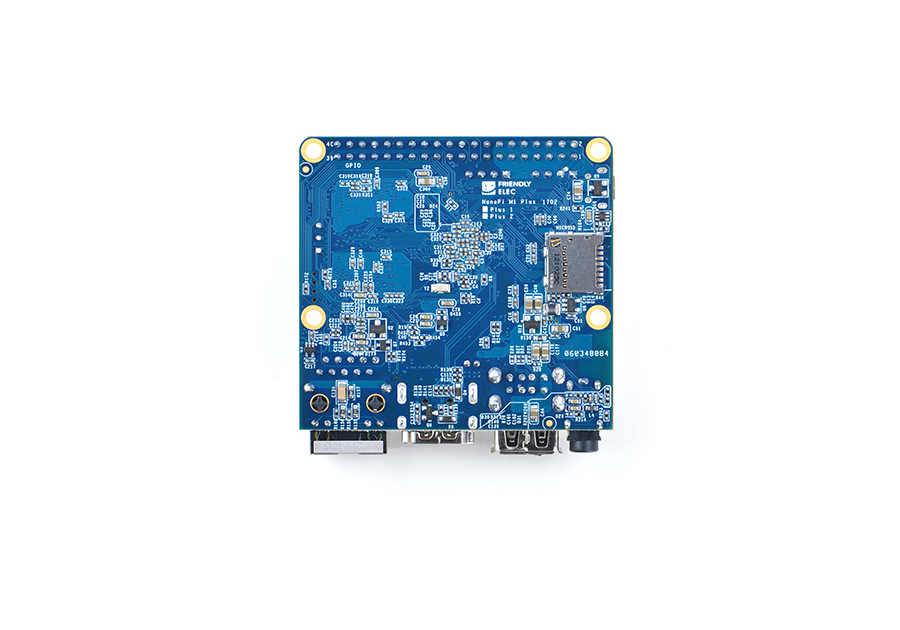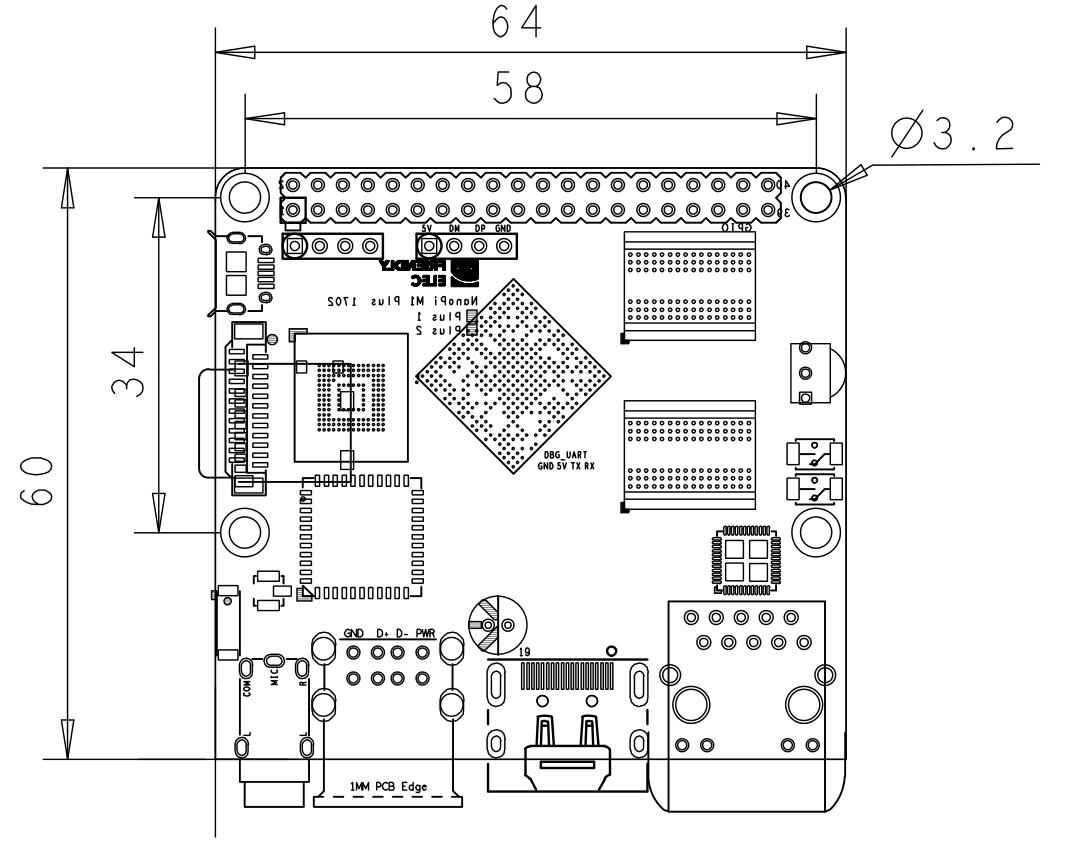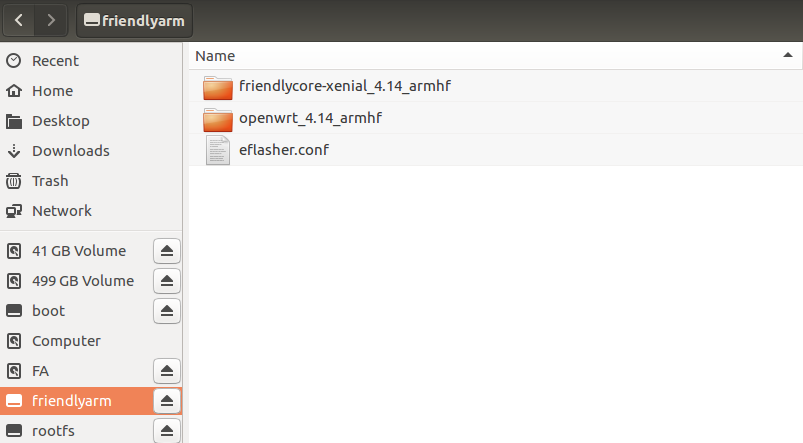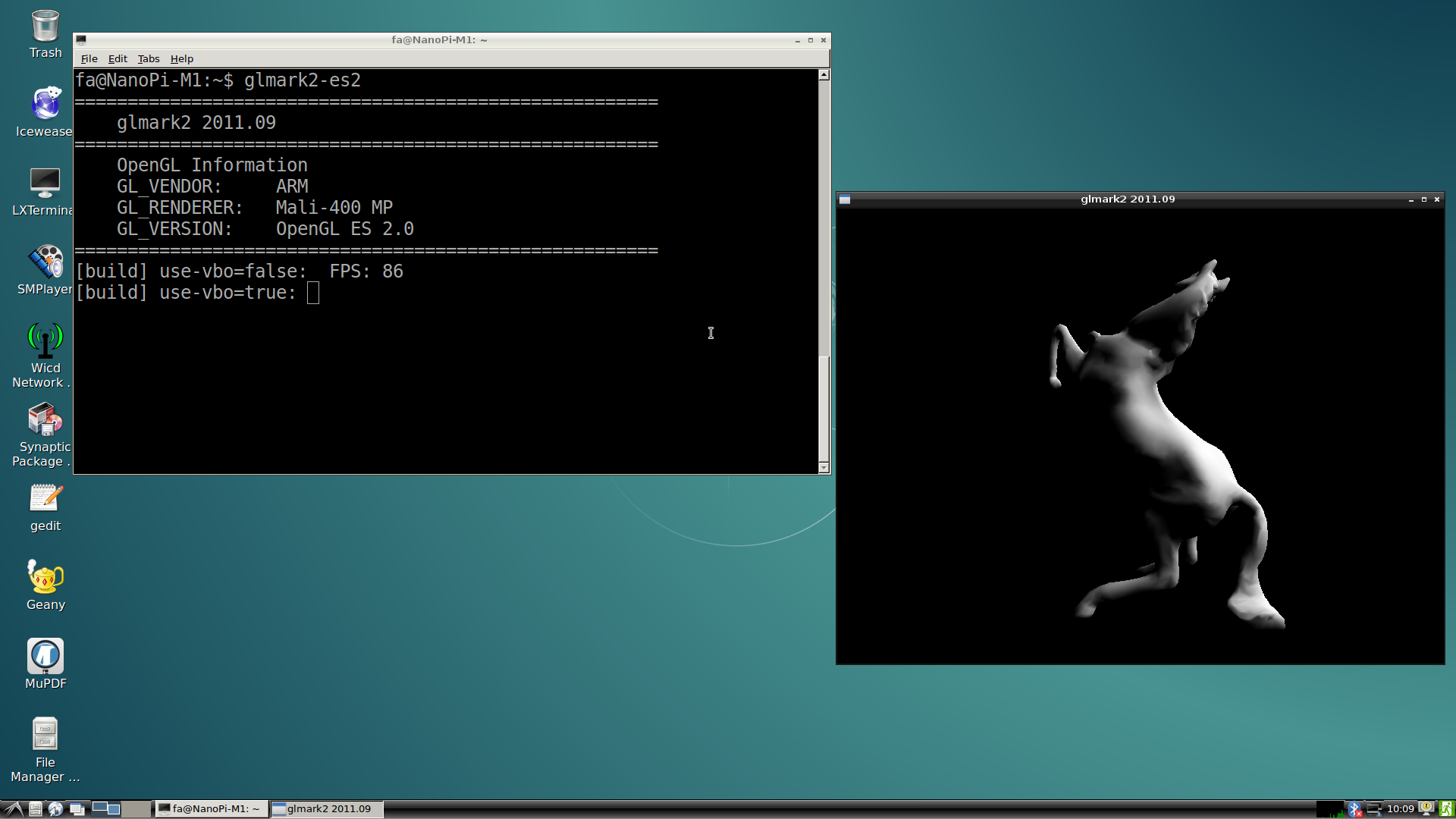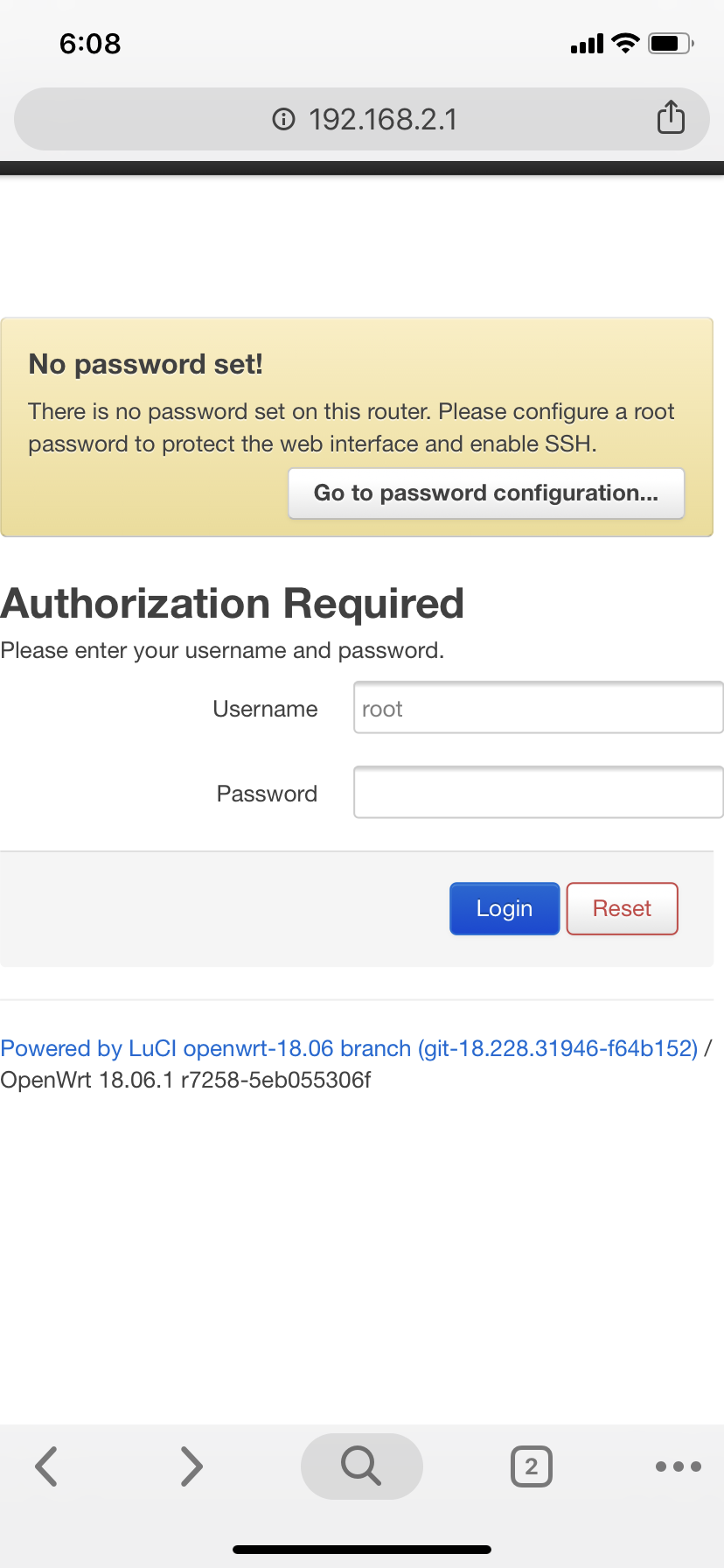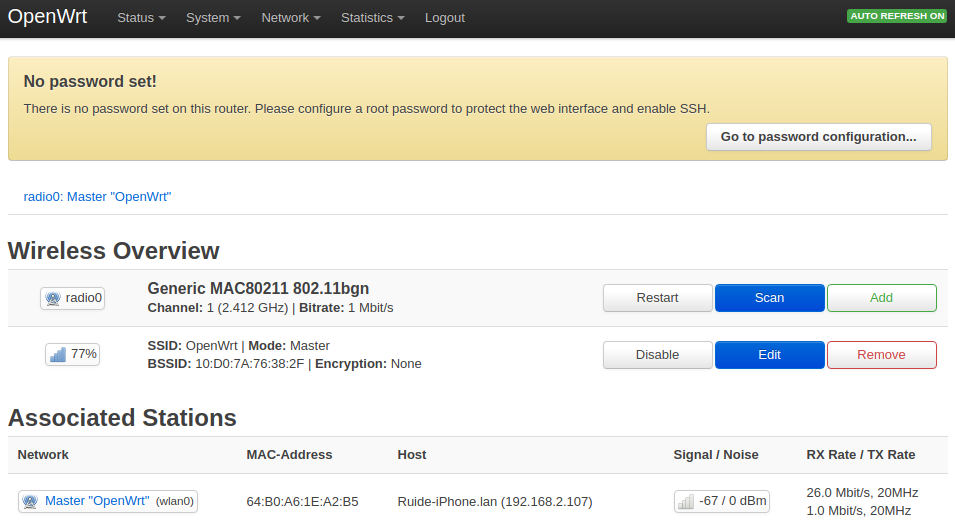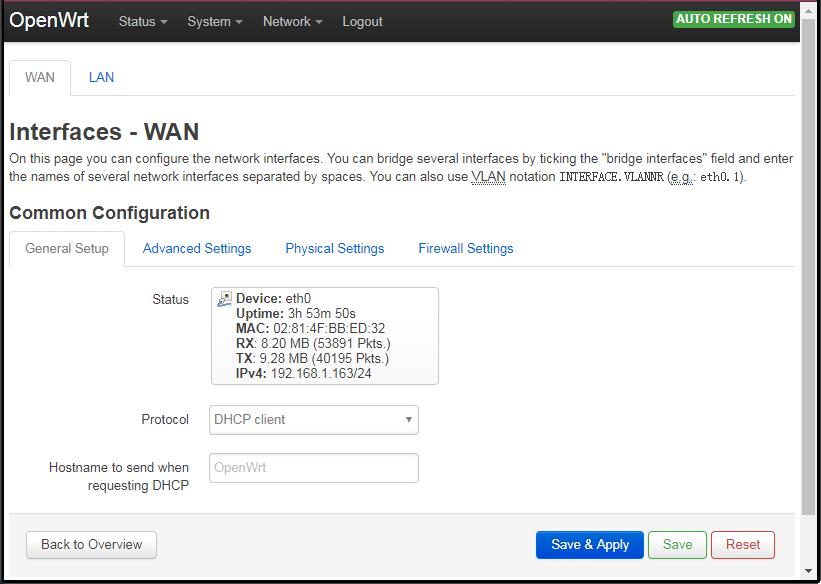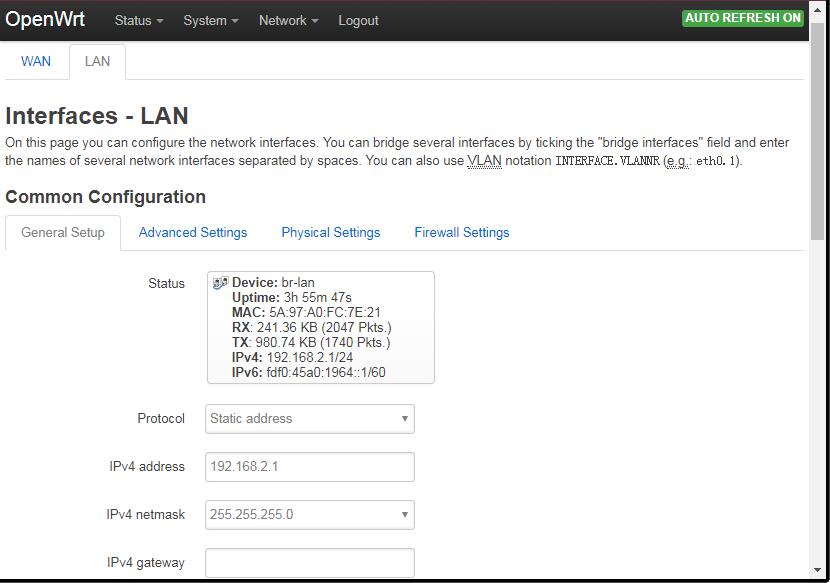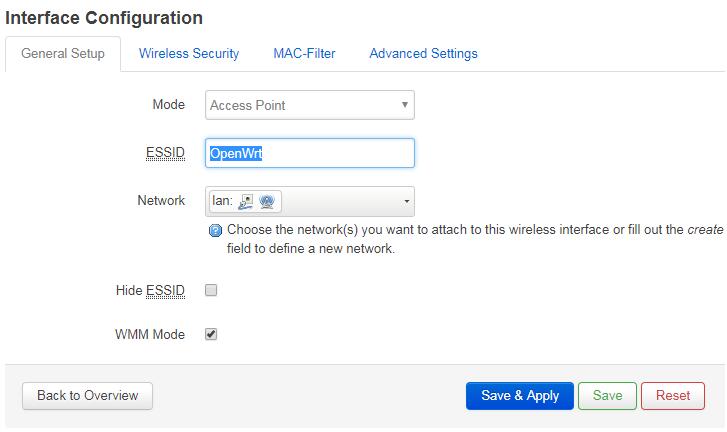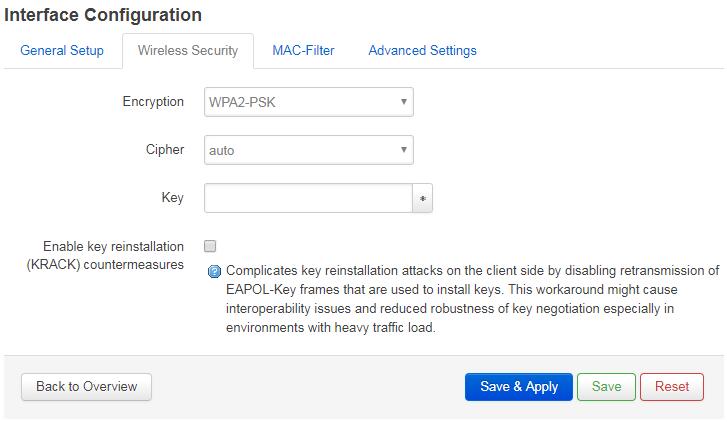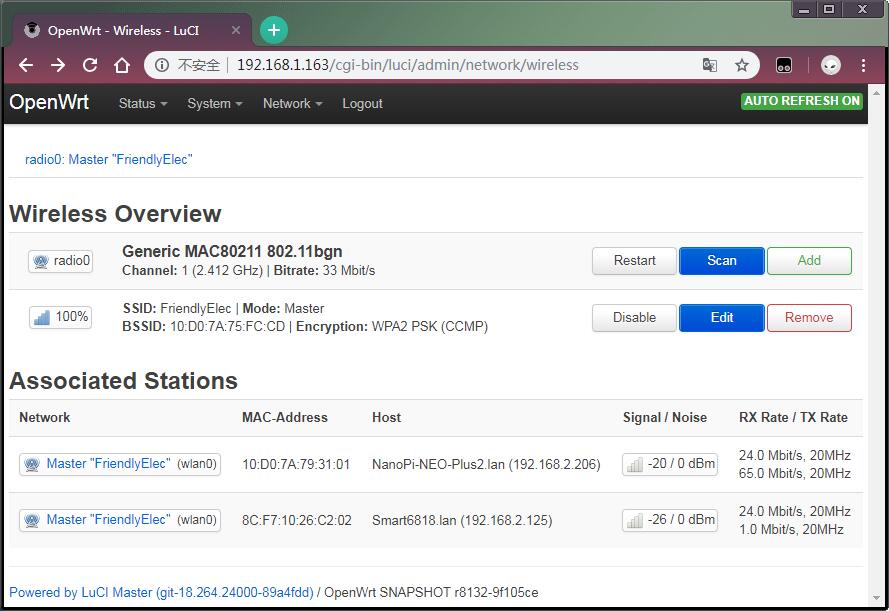Difference between revisions of "NanoPi M1 Plus"
(updated by API) |
(updated by API) |
||
| Line 293: | Line 293: | ||
* 当手机等设备成功连接到开发板的WiFi热点后,在LuCI的Netwrok ---> Wireless界面里可以查看已成功连接的设备:<br> | * 当手机等设备成功连接到开发板的WiFi热点后,在LuCI的Netwrok ---> Wireless界面里可以查看已成功连接的设备:<br> | ||
[[File:openwrt_wifiap_connected.png|frameless|600px|openwrt_wifiap_connected]] <br> | [[File:openwrt_wifiap_connected.png|frameless|600px|openwrt_wifiap_connected]] <br> | ||
| − | |||
| − | |||
| − | |||
| − | |||
| − | |||
| − | |||
| − | |||
| − | |||
| − | |||
===软件包管理=== | ===软件包管理=== | ||
Revision as of 05:18, 20 March 2019
Contents
[hide]- 1 Introduction
- 2 Hardware Spec
- 3 Software Features
- 4 Diagram, Layout and Dimension
- 5 Get Started
- 6 Working with Debian
- 6.1 Ethernet Connection
- 6.2 Wireless Connection
- 6.3 Setup Wi-Fi Hotspot
- 6.4 Install Debian Packages
- 6.5 Set Audio Device
- 6.6 Login via VNC and SSH
- 6.7 Connect to USB Camera(FA-CAM202)
- 6.8 Use OpenCV to Access Camera
- 6.9 Connect to DVP Camera CAM500B
- 6.10 Check CPU's Working Temperature
- 6.11 Test GPU
- 6.12 Test VPU
- 7 Work with FriendlyCore
- 7.1 Introduction
- 7.2 System Login
- 7.3 Configure System with npi-config
- 7.4 Develop Qt Application
- 7.5 Setup Program to AutoRun
- 7.6 Extend TF Card's Section
- 7.7 Transfer files using Bluetooth
- 7.8 WiFi
- 7.9 Setup Wi-Fi Hotspot
- 7.10 Bluetooth
- 7.11 Ethernet Connection
- 7.12 WiringPi and Python Wrapper
- 7.13 Custom welcome message
- 7.14 Modify timezone
- 7.15 Set Audio Device
- 7.16 Connect to DVP Camera CAM500B
- 7.17 Connect to USB Camera(FA-CAM202)
- 7.18 Check CPU's Working Temperature
- 7.19 Test Infrared Receiver
- 7.20 Run Qt Demo
- 7.21 How to install and use docker (for armhf system)
- 8 OpenWrt的使用
- 9 Build Linux System
- 10 Applications under Android
- 11 Make Your Own Android
- 12 Developer's Guide
- 13 3D Housing Printing Files
- 14 Resources
- 15 Update Log
1 Introduction
- The NanoPi M1 Plus is designed and developed by FriendlyElec for professionals, enterprise users, makers and hobbyists. It is only two thirds the size of a Raspberry Pi. FriendlyElec has made a Debian, Ubuntu-Core and Android images ready for it.
- The NanoPi M1 Plus uses the Allwinner H3 Soc. It integrates Gbps Ethernet, IR receiver, video/audio output, WiFi & Bluetooth, onboard microphone and supports DVP/Camera/HDMI and CVBS. It has a serial debug port. Its GPIO pins are compatible with those of a Raspberry Pi.
2 Hardware Spec
- CPU: Allwinner H3, Quad-core Cortex-A7@1.2GHz
- GPU: Mali400MP2@600MHz,Supports OpenGL ES2.0
- DDR3 RAM: 1GB
- eMMC: 8GB
- Wireless: 802.11 b/g/n
- Bluetooth: 4.0 dual mode
- Antenna Interface: Shared by WiFi and Bluetooth, IPX interface
- Connectivity: 10/100/1000M Ethernet
- Audio: 3.5mm jack/Via HDMI
- Microphone: onboard microphone
- IR: onboard IR receiver
- USB Host: USB 2.0 x 3, 2 x USB Type A and 1 x 2.54mm pitch pin-header
- MicroSD Slot: x1
- MicroUSB: power input and data transmission, OTG
- Audio Output: HDMI 1.4 1080P, CVBS
- DVP Camera Interface: 24pin, 0.5mm pitch FPC seat
- Serial Debug Port: 4Pin, 2.54mm pitch pin-header
- GPIO: 40pin, 2.54mm pitch pin-header, compatible with RasberryPi 2's GPIO. It contains UART, SPI, I2C, I2S/PCM, SPDIF-OUT and IO
- User Button: 1 x Power Button and 1 x Reset Button
- LED: 1 x Power LED and 1 x System Status LED
- PCB Dimension: 64 x 60 mm, ENIG
- Power Supply: DC 5V/2A
- Working Temperature: -30℃ to 80℃
- OS/Software: u-boot, Debian, Ubuntu-Core, eflasher, Android
3 Software Features
3.1 uboot
- mainline uboot released on May 2017
3.2 UbuntuCore 16.04
- mainline kernel: Linux-4.14
- rpi-monitor: check system status and information
- npi-config: system configuration utility for setting passwords, language, timezone, hostname, SSH and auto-login
- networkmanager: manage network
- welcome window with basic system information and status
- auto-login with user account "pi" with access to npi-config
- supports USB WiFi module: refer to #Test USB WiFi
- fixed MAC address
3.3 Eflasher
- supports flashing OS image to eMMC
3.4 Debian
- rpi-monitor: check system status and information
- npi-config: system configuration utility for setting passwords, language, timezone, hostname, SSH and auto-login
- supports Ethernet
- supports USB WiFi module: refer to #Test USB WiFi
- supports FriendlyElec's CAM202 USB camera
- supports FriendlyElec's CAM500B DVP camera
3.5 Debian for NAS Dock
- supports FriendlyElec's NAS Dock
3.6 Android
- supports Ethernet
- supports WiFi
4 Diagram, Layout and Dimension
4.1 Layout
- GPIO Pin Description
Pin# Name Linux gpio Pin# Name Linux gpio 1 SYS_3.3V 2 VDD_5V 3 I2C0_SDA/GPIOA12 4 VDD_5V 5 I2C0_SCL/GPIOA11 6 GND 7 GPIOG11 203 8 UART1_TX/GPIOG6 198 9 GND 10 UART1_RX/GPIOG7 199 11 UART2_TX/GPIOA0 0 12 GPIOA6 6 13 UART2_RTS/GPIOA2 2 14 GND 15 UART2_CTS/GPIOA3 3 16 UART1_RTS/GPIOG8 200 17 SYS_3.3V 18 UART1_CTS/GPIOG9 201 19 SPI0_MOSI/GPIOC0 64 20 GND 21 SPI0_MISO/GPIOC1 65 22 UART2_RX/GPIOA1 1 23 SPI0_CLK/GPIOC2 66 24 SPI0_CS/GPIOC3 67 25 GND 26 SPDIF-OUT/GPIOA17 17 27 I2C1_SDA/GPIOA19/PCM0_CLK/I2S0_BCK 19 28 I2C1_SCL/GPIOA18/PCM0_SYNC/I2S0_LRCK 18 29 GPIOA20/PCM0_DOUT/I2S0_SDOUT 20 30 GND 31 GPIOA21/PCM0_DIN/I2S0_SDIN 21 32 NC 33 NC 34 GND 35 NC 36 NC 37 GPIOA9 9 38 NC 39 GND 40 NC
- Debug Port(UART0)
Pin# Name 1 GND 2 VDD_5V 3 UART_TXD0/GPIOA4 4 UART_RXD0/GPIOA5/PWM0
- USB Pin Header
Pin# Name 1 5V 2 DM 3 DP 4 GND
- DVP Camera Interface Pin Description
Pin# Name Description 1, 2 SYS_3.3V 3.3V Output, it can be used to power camera modules 7,9,13,15,24 GND Ground, 0V 3 I2C2_SCL I2C clock signal 4 I2C2_SDA I2C data signal 5 GPIOE15 regular GPIO, used to control connected camera modules 6 GPIOE14 regular GPIO, used to control connected camera modules 8 MCLK Clock signals output to camera modules 10 NC Not connected 11 VSYNC vertical synchronization 12 HREF/HSYNC horizontal synchronization==Make Your Own Debian/Ubuntu====Make Your Own Debian/Ubuntu== 14 PCLK peripheral clock 16-23 Data bit7-0 data bits
- Notes
- SYS_3.3V: 3.3V power output
- VDD_5V: 5V power output5V. When the external device’s power is greater than the MicroUSB’s the external device is charging the board otherwise the board powers the external device.The input range is 4.7V ~ 5.6V
- All pins are 3.3V, output current is 5mA
- For more details refer to the document:NanoPi-M1-Plus-1702-Schematic.pdf
4.2 Board Dimension
- For more details please refer to the document:pcb in dxf format
5 Get Started
5.1 Essentials You Need
Before starting to use your NanoPi M1 Plus get the following items ready
- NanoPi M1 Plus
- microSD Card/TFCard: Class 10 or Above, minimum 8GB SDHC
- microUSB power. A 5V/2A power is a must
- HDMI monitor
- USB keyboard, mouse and possible a USB hub(or a TTL to serial board)
- A host computer running Ubuntu 16.04 64 bit system
5.2 TF Cards We Tested
To make your NanoPi M1 Plus boot and run fast we highly recommend you use a Class10 8GB SDHC TF card or a better one. The following cards are what we used in all our test cases presented here:
- SanDisk TF 8G Class10 Micro/SD TF card:
- SanDisk TF128G MicroSDXC TF 128G Class10 48MB/S:
- 川宇 8G C10 High Speed class10 micro SD card:
5.3 Install OS
5.3.1 Download Image Files
Get the following files from here download link to download image files (under the "officail-ROMs" diirectory) and the flashing utility (under the "tools" diirectory):
Image Files: nanopi-m1-plus_sd_friendlycore-xenial_3.4_armhf_YYYYMMDD.img.zip FriendlyCore, kernel:Linux-3.4 nanopi-m1-plus_sd_friendlycore-xenial_4.14_armhf_YYYYMMDD.img.zip FriendlyCore, kernel:Linux-4.14 nanopi-m1-plus_sd_debian-jessie_3.4_armhf_YYYYMMDD.img.zip Debian-Desktop, kernel:Linux-3.4 nanopi-m1-plus_sd_debian-jessie_4.14_armhf_YYYYMMDD.img.zip Debian-Desktop, kernel:Linux-4.14 nanopi-m1-plus_sd_openwrt_4.14_armhf_YYYYMMDD.img.zip OpenWrt, kernel:Linux-4.14 nanopi-m1-plus_eflasher_debian-jessie_4.14_armhf_YYYYMMDD.img.zip eflasher image, for flashing Debian(Linux-4.14) to eMMC nanopi-m1-plus_eflasher_friendlycore-xenial_4.14_armhf_YYYYMMDD.img.zip eflasher image, for flashing FriendlyCore(Linux-4.14) to eMMC nanopi-m1-plus_eflasher_openwrt_4.14_armhf_YYYYMMDD.img.zip eflasher image, for flashing OpenWrt(Linux-4.14) to eMMC nanopi-m1-plus_sd_android_YYYYMMDD.img.zip Android, kernel:Linux-3.4 Flash Utility: win32diskimager.rar Windows utility. Under Linux users can use "dd" PhoenixCard_V310.rar Windows utility for flashing Android image. Attention: the "dd" command under Linux doesn't work for flashing Android image HDDLLF.4.40.exe Windows utility for formatting a TF card
5.3.2 Comparison of Linux-3.4 and Linux-4.14
- Our Linux-3.4 is provided by Allwinner. Allwinner has done a lot of customization work which on one hand contains many features and functions but on the other hand incurs overheat issues. If your application needs to use VPU or GPU you need to use the 3.4 kernel based ROM and use a heat sink together with your board.
- Our Linux-4.14 is based on the mainline kernel. We will keep this kernel with the latest one released by Linus Torvalds. This kernel is stable and doesn't generate heat that much. If your application doesn't need to use VPU or GPU we recommend you to use this kernel.
- For more details about the Linux-4.14 kernel refer to: Building U-boot and Linux for H5/H3/H2+
5.3.2.1 Flash to eMMC
5.3.2.1.1 Flash OS with eflasher Utility
- For more details about eflasher refer to the wiki link: EFlasher。
- Extract the eflasher Image and win32diskimager.rar files. Insert a TF card(at least 4G) into a Windows PC and run the win32diskimager utility as administrator. On the utility's main window select your TF card's drive, the wanted image file and click on "write" to start flashing the TF card.
- Insert this card into your board's BOOT slot and power on (with a 5V/2A power source). If the green LED is on and the blue LED is blinking this indicates your board has successfully booted.
- If your board doesn't support HDMI or no monitor is connected you can select an OS by running the following command:
$ su root
$ eflasherThe password for "root" is "fa".
We take "nanopi-m1-plus_eflasher_friendlycore-xenial_4.14_armhf_YYYYMMDD.img" as an example. After you run the "eflasher" command you will see the following messages:
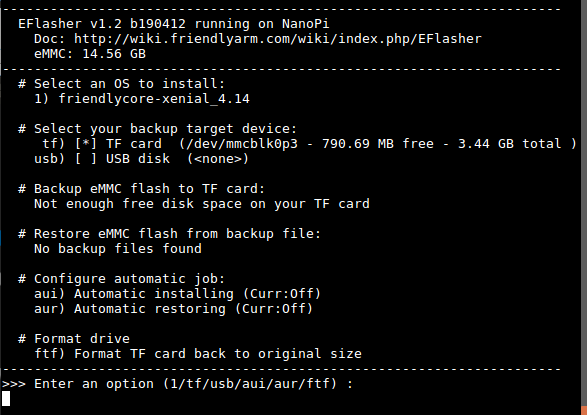
Type "1", select writing friendlycore system to eMMC you will see the following messages:
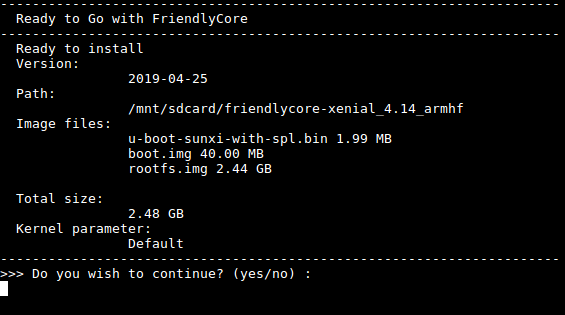
Type "yes" to start installation:

After it is done power off the system, take off the TF card, power on again your system will be booted from eMMC.
- If you want to flash other system to eMMC you can download the whole images-for-eflasher directory and extract the package under that directory to the FRIENDLYARM partition of an installation SD card.
5.3.3 Android
5.3.3.1 Flash to TF
Note:before make a MicroSD card to an Android image card you need to format this card.
- On a Windows PC run the HDDLLF.4.40 utility as administrator. Insert a TF card(at least 8G) into this PC and format it. After formatting is done take out the TF card, insert it into the PC again and format it with Windows internal format utility to format it to FAT32. After this formatting is done take out the card.
- Extract the the Android image and PhoenixCard_V310.rar . Insert the TF card you made in the previous step into a Windows PC and run the PhoenixCard_V310 utility as administrator. On the utility's main window select your TF card's drive, the wanted image file and click on "write" to start flashing the TF card.
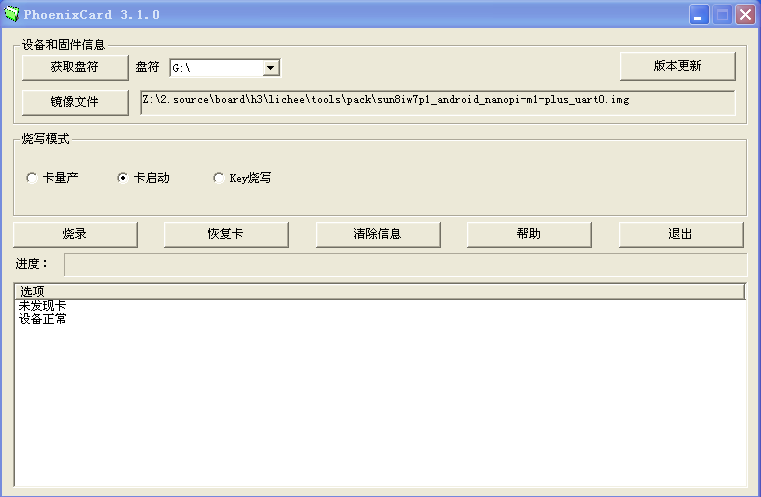
(In the screenshot an Android image file for the NanoPi M1 Plus was selected. You need to select a correct image file for your board.)
- Insert this card into your board' BOOT slot and power on (with a 5V/2A power source). If the green LED is on and the blue LED is blinking this indicates your board has successfully booted.
5.3.3.2 Flash to eMMC
5.3.3.2.1 Install Android to eMMC from TF Card
- Extract an Android image file and the flashing utility PhoenixCard_V310.rar, insert a TF card(at least 8G) to a windows PC and run PhoenixCard as administrator. On the PhoenixCard Window select your TF card's device and your wanted Android image file, set the mode to "卡量产(factory production)" and click on "烧录(Flash)" to start flashing the Android image to TF card.
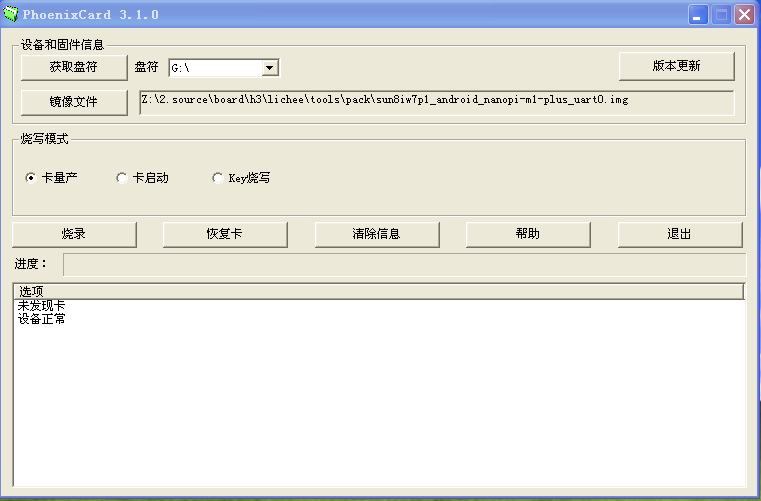
(In the screenshot an Android image file for the NanoPi M1 Plus was selected. You need to select a correct image file for your board.)
- After flashing is done, the TF card has the ability to burn the Android system to eMMC. Take out the TF card and insert it to your board's TF card slot. Connect your board to an HDMI monitor, power on your board(note:you need a 5V/2A power adapter) and you will see a green process bar on the HDMI monitor. After flashing is done take out the TF card and reboot your board and it will be rebooted from eMMC.
6 Working with Debian
6.1 Ethernet Connection
- If the board is connected to a network via Ethernet before it is powered on, it will automatically obtain an IP after it is powered up.
6.2 Wireless Connection
Under Debian you can manage your network with NetworkManager.
After Debian boots click on the network icon on the bottom right of the task bar a NetworkManger menu will pop up and all the available networks will be listed. If there is an active wireless network you will see something similar to the following screenshot:
![]()
You can click on a WiFI AP and connect your board to it.
For more details refer to:NetworkManager.
For either an SD WiFi or a USB WiFi you can connect it to your board in the same way. The APXX series WiFi chips are SD WiFi chips. By default FriendlyElec's system supports most popular USB WiFi modules. Here is a list of the USB WiFi modules we tested:
Index Model 1 RTL8188CUS/8188EU 802.11n WLAN Adapter 2 RT2070 Wireless Adapter 3 RT2870/RT3070 Wireless Adapter 4 RTL8192CU Wireless Adapter 5 mi WiFi mt7601 6 5G USB WiFi RTL8821CU 7 5G USB WiFi RTL8812AU
You can use the NetworkManager utility to manage network. You can run "nmcli" in the commandline utility to start it. Here are the commands to start a WiFi connection:
- Change to root
$ su root
- Check device list
$ nmcli devNote: if the status of a device is "unmanaged" it means that device cannot be accessed by NetworkManager. To make it accessed you need to clear the settings under "/etc/network/interfaces" and reboot your system.
- Start WiFi
$ nmcli r wifi on- Scan Surrounding WiFi Sources
$ nmcli dev wifi- Connect to a WiFi Source
$ nmcli dev wifi connect "SSID" password "PASSWORD" ifname wlan0
The "SSID" and "PASSWORD" need to be replaced with your actual SSID and password.If you have multiple WiFi devices you need to specify the one you want to connect to a WiFi source with iface
If a connection succeeds it will be automatically setup on next system reboot.
For more details about NetworkManager refer to this link: Use NetworkManager to configure network settings
If your USB WiFi module doesn't work most likely your system doesn't have its driver. For a Debian system you can get a driver from Debian-WiFi and install it on your system. For a Ubuntu system you can install a driver by running the following commands:
$ apt-get install linux-firmware
In general all WiFi drivers are located at the "/lib/firmware" directory.
6.3 Setup Wi-Fi Hotspot
Run the following command to enter AP mode:
$ su root $ turn-wifi-into-apmode yes
You will be prompted to type your WiFi hotspot's name and password and then proceed with default prompts.
After this is done you will be able to find this hotspot in a neadby cell phone or PC. You can login to this board at 192.168.8.1:
$ ssh root@192.168.8.1
When asked to type a password you can type "fa".
To speed up your ssh login you can turn off your wifi by running the following command:
$ iwconfig wlan0 power offTo switch back to Station mode run the following command:
$ turn-wifi-into-apmode no6.4 Install Debian Packages
We provide a Debian Jessie image. You can install Jessie's packages by commanding "apt-get". If this is your first installation you need to update the package list by running the following command
apt-get updateYou can install your preferred packages. For example if you want to install an FTP server you can do this:
apt-get install vsftpdNote: you can change your download server by editting "/etc/apt/sources.list". You can get a complete server list from [1]. You need to select the one with "armhf".
6.5 Set Audio Device
If your system has multiple audio devices such as HDMI-Audio, 3.5mm audio jack and I2S-Codec you can set system's default audio device by running the following commands.
- After your board is booted run the following commands to install alsa packages:
$ apt-get update $ apt-get install libasound2 $ apt-get install alsa-base $ apt-get install alsa-utils
- After installation is done you can list all the audio devices by running the following command. Here is a similar list you may see after you run the command:
$ aplay -l card 0: HDMI card 1: 3.5mm codec card 2: I2S codec
"card 0" is HDMI-Audio, "card 1" is 3.5mm audio jack and "card 2" is I2S-Codec. You can set default audio device to HDMI-Audio by changing the "/etc/asound.conf" file as follows:
pcm.!default { type hw card 0 device 0 } ctl.!default { type hw card 0 }
If you change "card 0" to "card 1" the 3.5mm audio jack will be set to the default device.
Copy a .wav file to your board and test it by running the following command:
$ aplay /root/Music/test.wav
You will hear sounds from system's default audio device.
If you are using H3/H5/H2+ series board with mainline kernel, the easier way is using npi-config。
6.6 Login via VNC and SSH
If your board is not connected to a display device you can login to your board from a mobile phone. You need to download and install a "VNC Viewer" from here on a mobile phone and login to the board via VNC at port 1. Its default password is "fa123456".
Here is a screenshot which shows how it looks like when users login to the board from an iPhone via VNC:

In our case our board's IP address is 192.168.1.230. You can login via SSH by running the following commands:
$ ssh root@192.168.1.230
The password is fa.
6.7 Connect to USB Camera(FA-CAM202)
The FA-CAM202 is a 200M USB camera.
Refer to this link for more details on how to connect to a FA-CAM202:
Connect NanoPi M1 to DVP Camera CAM500B
In Debian, click on "other"-->"xawtv" on the left bottom of the GUI and the USB Camera application will be started. After enter "welcome to xawtv!" click on "OK" to start exploring.
6.8 Use OpenCV to Access Camera
- The full name of "OpenCV" is Open Source Computer Vision Library and it is a cross platform vision library.
- Make sure your board is connected to the internet and an HDMI monitor, Boot Debian and login.
- Install OpenCV libraries:
$ apt-get update $ apt-get install libcv-dev libopencv-dev
- Refer to the instructions in the previous sections to make sure the camera works
- Compile and run a code sample(Official Code Sample in C++ provided by the OpenCV organization):
$ cd /home/fa/Documents/opencv-demo $ make $ ./demo
6.9 Connect to DVP Camera CAM500B
The CAM500B camera module is a 5M-pixel camera with DVP interface. For more tech details about it you can refer to Matrix - CAM500B.
connect your H3 board to a CAM500B. Then boot OS, connect your board to a network, log into the board as root and run "mjpg-streamer":
$ cd /root/mjpg-streamer $ make $ ./start.sh
The mjpg-streamer application is an open source video steam server. After it is successfully started the following messages will be popped up:
i: Using V4L2 device.: /dev/video0 i: Desired Resolution: 1280 x 720 i: Frames Per Second.: 30 i: Format............: YUV i: JPEG Quality......: 90 o: www-folder-path...: ./www/ o: HTTP TCP port.....: 8080 o: username:password.: disabled o: commands..........: enabled
In our case the board's IP address was 192.168.1.230. We typed 192.168.1.230:8080 in a browser and were able to view the images taken from the camera's. Here is what you would expect to observe:

The mjpg-streamer utility uses libjpeg to software-encode steam data. The Linux-4.x based ROM currently doesn't support hardware-encoding. If you use a Linux-3.x based ROM you can use the ffmpeg utility to hardware-encode stream data and this can greatly release CPU's resources and speed up encoding:
$ ffmpeg -t 30 -f v4l2 -channel 0 -video_size 1280x720 -i /dev/video0 -pix_fmt nv12 -r 30 \ -b:v 64k -c:v cedrus264 test.mp4
By default it records a 30-second video. Typing "q" stops video recording. After recording is stopped a test.mp4 file will be generated.
6.10 Check CPU's Working Temperature
You can use the following command to read H3's temperature and frequency
cpu_freq
6.11 Test GPU
Note: this function is only supported in Allwinner Linux-3.4.y.
After OS loads please login from a terminal and run the following command:
glmark2-es2
6.12 Test VPU
Note: this function is only supported in Allwinner Linux-3.4.y
Visit this link download link to download files
After OS is loaded login from a terminal and run the following commands:
$ sudo apt-get install mpv $ video_play mpv ./big_buck_bunny_1080p_H264_AAC_25fps_7200K.MP4
In our test it could do hard coding and play 1080P video fluently.
7 Work with FriendlyCore
7.1 Introduction
FriendlyCore is a light Linux system without X-windows, based on ubuntu core, It uses the Qt-Embedded's GUI and is popular in industrial and enterprise applications.
Besides the regular Ubuntu Core's features FriendlyCore has the following additional features:
- it integrates Qt4.8;
- it integrates NetworkManager;
- it has bluez and Bluetooth related packages;
- it has alsa packages;
- it has npi-config;
- it has RPiGPIO, a Python GPIO module;
- it has some Python/C demo in /root/ directory;
- it enables 512M-swap partition;
7.2 System Login
- If your board is connected to an HDMI monitor you need to use a USB mouse and keyboard.
- If you want to do kernel development you need to use a serial communication board, ie a PSU-ONECOM board, which will
allow you to operate the board via a serial terminal.Here is a setup where we connect a board to a PC via the PSU-ONECOM and you can power on your board from either the PSU-ONECOM or its MicroUSB:
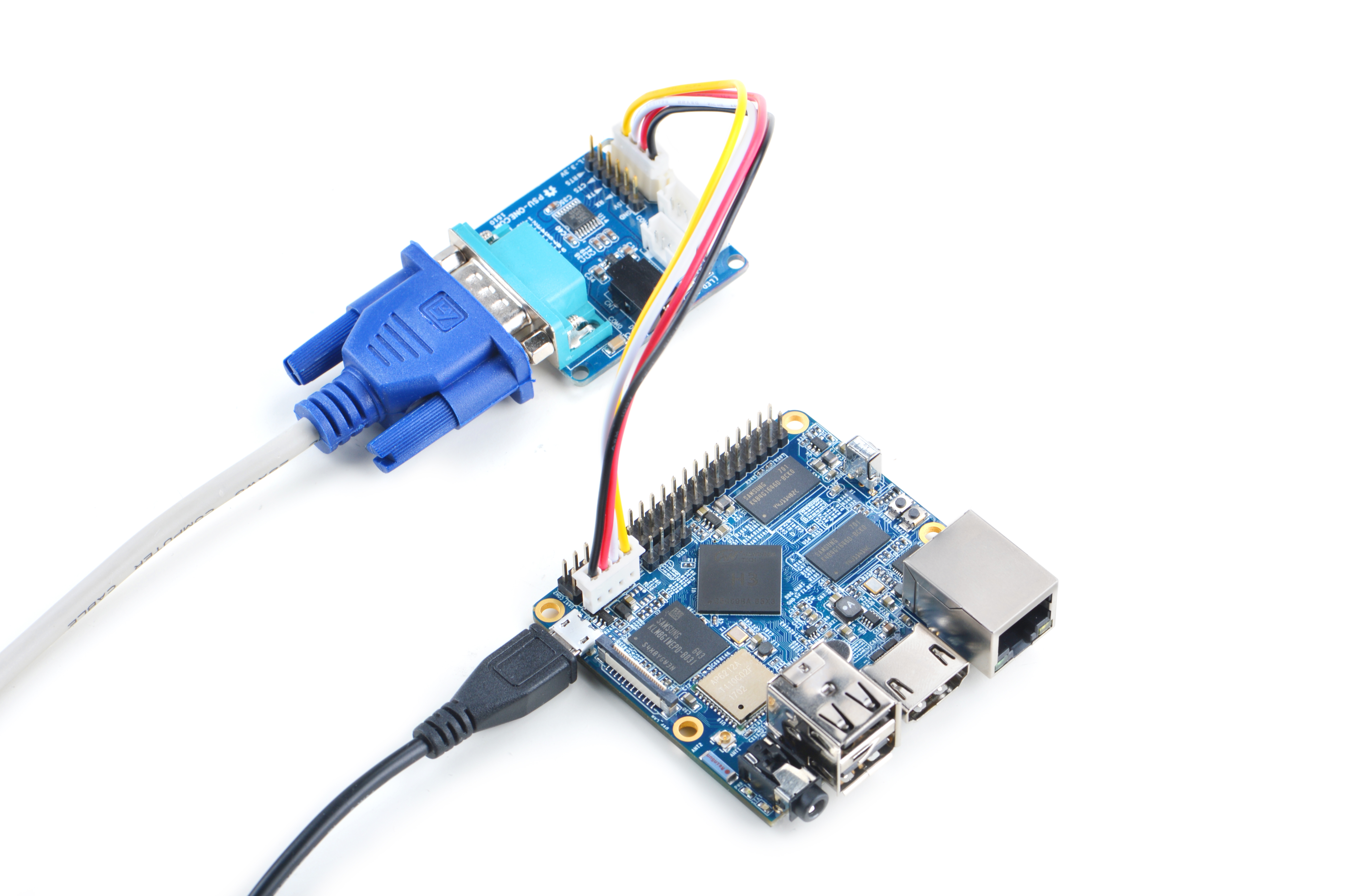
You can use a USB to Serial conversion board too.
Make sure you use a 5V/2A power to power your board from its MicroUSB port:
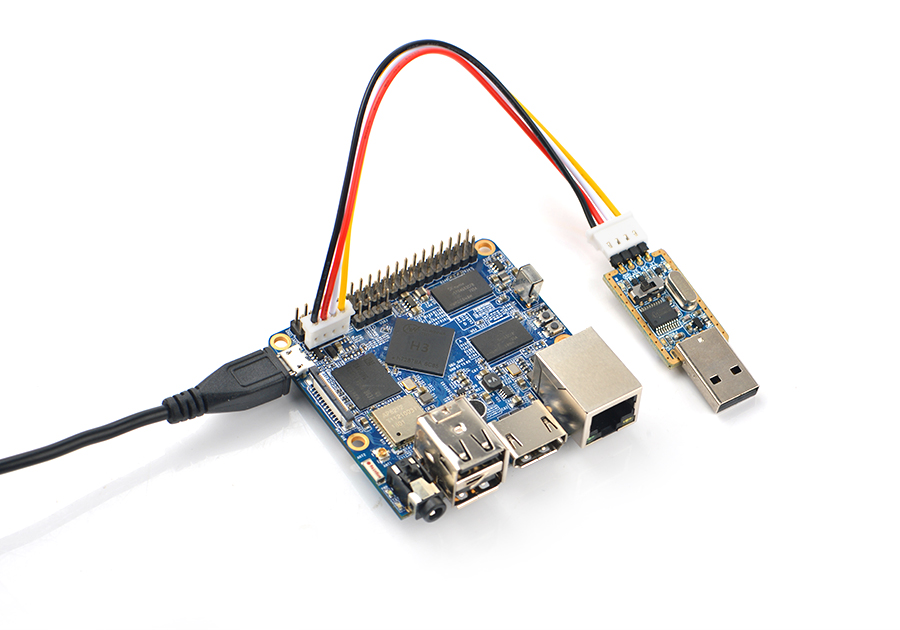
- FriendlyCore User Accounts:
Non-root User:
User Name: pi Password: pi
Root:
User Name: root Password: fa
The system is automatically logged in as "pi". You can do "sudo npi-config" to disable auto login.
- Update packages
$ sudo apt-get update
7.3 Configure System with npi-config
The npi-config is a commandline utility which can be used to initialize system configurations such as user password, system language, time zone, Hostname, SSH switch , Auto login and etc. Type the following command to run this utility.
$ sudo npi-config
Here is how npi-config's GUI looks like:

7.4 Develop Qt Application
Please refer to: How to Build and Install Qt Application for FriendlyELEC Boards
7.5 Setup Program to AutoRun
You can setup a program to autorun on system boot with npi-config:
sudo npi-configGo to Boot Options -> Autologin -> Qt/Embedded, select Enable and reboot.
7.6 Extend TF Card's Section
When FriendlyCore is loaded the TF card's section will be automatically extended.You can check the section's size by running the following command:
$ df -h
7.7 Transfer files using Bluetooth
Take the example of transferring files to the mobile phone. First, set your mobile phone Bluetooth to detectable status, then execute the following command to start Bluetooth search.:
hcitool scan
Search results look like:
Scanning ...
2C:8A:72:1D:46:02 HTC6525LVWThis means that a mobile phone named HTC6525LVW is searched. We write down the MAC address in front of the phone name, and then use the sdptool command to view the Bluetooth service supported by the phone:
sdptool browser 2C:8A:72:1D:46:02
Note: Please replace the MAC address in the above command with the actual Bluetooth MAC address of the mobile phone.
This command will detail the protocols supported by Bluetooth for mobile phones. What we need to care about is a file transfer service called OBEX Object Push. Take the HTC6525LVW mobile phone as an example. The results are as follows:
Service Name: OBEX Object Push Service RecHandle: 0x1000b Service Class ID List: "OBEX Object Push" (0x1105) Protocol Descriptor List: "L2CAP" (0x0100) "RFCOMM" (0x0003) Channel: 12 "OBEX" (0x0008) Profile Descriptor List: "OBEX Object Push" (0x1105) Version: 0x0100
As can be seen from the above information, the channel used by the OBEX Object Push service of this mobile phone is 12, we need to pass it to the obexftp command, and finally the command to initiate the file transfer request is as follows:
obexftp --nopath --noconn --uuid none --bluetooth -b 2C:8A:72:1D:46:02 -B 12 -put example.jpg
Note: Please replace the MAC address, channel and file name in the above command with the actual one.
After executing the above commands, please pay attention to the screen of the mobile phone. The mobile phone will pop up a prompt for pairing and receiving files. After confirming, the file transfer will start.
Bluetooth FAQ:
1) Bluetooth device not found on the development board, try to open Bluetooth with the following command:
rfkill unblock 02) Prompt can not find the relevant command, you can try to install related software with the following command:
apt-get install bluetooth bluez obexftp openobex-apps python-gobject ussp-push7.8 WiFi
For either an SD WiFi or a USB WiFi you can connect it to your board in the same way. The APXX series WiFi chips are SD WiFi chips. By default FriendlyElec's system supports most popular USB WiFi modules. Here is a list of the USB WiFi modules we tested:
Index Model 1 RTL8188CUS/8188EU 802.11n WLAN Adapter 2 RT2070 Wireless Adapter 3 RT2870/RT3070 Wireless Adapter 4 RTL8192CU Wireless Adapter 5 mi WiFi mt7601 6 5G USB WiFi RTL8821CU 7 5G USB WiFi RTL8812AU
You can use the NetworkManager utility to manage network. You can run "nmcli" in the commandline utility to start it. Here are the commands to start a WiFi connection:
- Change to root
$ su root
- Check device list
$ nmcli devNote: if the status of a device is "unmanaged" it means that device cannot be accessed by NetworkManager. To make it accessed you need to clear the settings under "/etc/network/interfaces" and reboot your system.
- Start WiFi
$ nmcli r wifi on- Scan Surrounding WiFi Sources
$ nmcli dev wifi- Connect to a WiFi Source
$ nmcli dev wifi connect "SSID" password "PASSWORD" ifname wlan0
The "SSID" and "PASSWORD" need to be replaced with your actual SSID and password.If you have multiple WiFi devices you need to specify the one you want to connect to a WiFi source with iface
If a connection succeeds it will be automatically setup on next system reboot.
For more details about NetworkManager refer to this link: Use NetworkManager to configure network settings
If your USB WiFi module doesn't work most likely your system doesn't have its driver. For a Debian system you can get a driver from Debian-WiFi and install it on your system. For a Ubuntu system you can install a driver by running the following commands:
$ apt-get install linux-firmware
In general all WiFi drivers are located at the "/lib/firmware" directory.
7.9 Setup Wi-Fi Hotspot
Run the following command to enter AP mode:
$ su root $ turn-wifi-into-apmode yes
You will be prompted to type your WiFi hotspot's name and password and then proceed with default prompts.
After this is done you will be able to find this hotspot in a neadby cell phone or PC. You can login to this board at 192.168.8.1:
$ ssh root@192.168.8.1
When asked to type a password you can type "fa".
To speed up your ssh login you can turn off your wifi by running the following command:
$ iwconfig wlan0 power offTo switch back to Station mode run the following command:
$ turn-wifi-into-apmode no7.10 Bluetooth
Search for surrounding bluetooth devices by running the following command:
$ su root
$ hciconfig hci0 up
$ hcitool scanYou can run "hciconfig" to check bluetooth's status.
7.11 Ethernet Connection
If a board is connected to a network via Ethernet before it is powered on it will automatically obtain an IP with DHCP activated after it is powered up. If you want to set up a static IP refer to: Use NetworkManager to configure network settings。
7.12 WiringPi and Python Wrapper
- WiringNP: NanoPi NEO/NEO2/Air GPIO Programming with C
- RPi.GPIO : NanoPi NEO/NEO2/Air GPIO Programming with Python
7.13 Custom welcome message
The welcome message is printed from the script in this directory:
/etc/update-motd.d/
For example, to change the FriendlyELEC LOGO, you can change the file /etc/update-motd.d/10-header. For example, to change the LOGO to HELLO, you can change the following line:
TERM=linux toilet -f standard -F metal $BOARD_VENDOR
To:
TERM=linux toilet -f standard -F metal HELLO
7.14 Modify timezone
For exampe, change to Shanghai timezone:
sudo rm /etc/localtime sudo ln -ls /usr/share/zoneinfo/Asia/Shanghai /etc/localtime
7.15 Set Audio Device
If your system has multiple audio devices such as HDMI-Audio, 3.5mm audio jack and I2S-Codec you can set system's default audio device by running the following commands.
- After your board is booted run the following commands to install alsa packages:
$ apt-get update $ apt-get install libasound2 $ apt-get install alsa-base $ apt-get install alsa-utils
- After installation is done you can list all the audio devices by running the following command. Here is a similar list you may see after you run the command:
$ aplay -l card 0: HDMI card 1: 3.5mm codec card 2: I2S codec
"card 0" is HDMI-Audio, "card 1" is 3.5mm audio jack and "card 2" is I2S-Codec. You can set default audio device to HDMI-Audio by changing the "/etc/asound.conf" file as follows:
pcm.!default { type hw card 0 device 0 } ctl.!default { type hw card 0 }
If you change "card 0" to "card 1" the 3.5mm audio jack will be set to the default device.
Copy a .wav file to your board and test it by running the following command:
$ aplay /root/Music/test.wav
You will hear sounds from system's default audio device.
If you are using H3/H5/H2+ series board with mainline kernel, the easier way is using npi-config。
7.16 Connect to DVP Camera CAM500B
For NanoPi-M1-Plus the CAM500B can work with both Linux-3.4 Kernel and Linux-4.14 Kernel.
The CAM500B camera module is a 5M-pixel camera with DVP interface. For more tech details about it you can refer to Matrix - CAM500B.
connect your board to camera module. Then boot OS, connect your board to a network, log into the board as root and run "mjpg-streamer":
$ cd /root/C/mjpg-streamer $ make $ ./start.sh
You need to change the start.sh script and make sure it uses a correct /dev/videoX node. You can check your camera's node by running the following commands:
$ apt-get install v4l-utils $ v4l2-ctl -d /dev/video0 -D Driver Info (not using libv4l2): Driver name : sun6i-video Card type : sun6i-csi Bus info : platform:camera Driver version: 4.14.0 ...
The above messages indicate that "/dev/video0" is camera's device node.The mjpg-streamer application is an open source video steam server. After it is successfully started the following messages will be popped up:
$ ./start.sh i: Using V4L2 device.: /dev/video0 i: Desired Resolution: 1280 x 720 i: Frames Per Second.: 30 i: Format............: YUV i: JPEG Quality......: 90 o: www-folder-path...: ./www/ o: HTTP TCP port.....: 8080 o: username:password.: disabled o: commands..........: enabled
start.sh runs the following two commands:
export LD_LIBRARY_PATH="$(pwd)" ./mjpg_streamer -i "./input_uvc.so -d /dev/video0 -y 1 -r 1280x720 -f 30 -q 90 -n -fb 0" -o "./output_http.so -w ./www"
Here are some details for mjpg_streamer's major options:
-i: input device. For example "input_uvc.so" means it takes input from a camera;
-o: output device. For example "output_http.so" means the it transmits data via http;
-d: input device's subparameter. It defines a camera's device node;
-y: input device's subparameter. It defines a camera's data format: 1:yuyv, 2:yvyu, 3:uyvy 4:vyuy. If this option isn't defined MJPEG will be set as the data format;
-r: input device's subparameter. It defines a camera's resolution;
-f: input device's subparameter. It defines a camera's fps. But whether this fps is supported depends on its driver;
-q: input device's subparameter. It defines the quality of an image generated by libjpeg soft-encoding;
-n: input device's subparameter. It disables the dynctrls function;
-fb: input device's subparameter. It specifies whether an input image is displayed at "/dev/fbX";
-w: output device's subparameter. It defines a directory to hold web pages;
In our case the board's IP address was 192.168.1.230. We typed 192.168.1.230:8080 in a browser and were able to view the images taken from the camera's. Here is what you would expect to observe:

The mjpg-streamer utility uses libjpeg to software-encode steam data. The Linux-4.14 based ROM currently doesn't support hardware-encoding. If you use a H3 boards with Linux-3.4 based ROM you can use the ffmpeg utility to hardware-encode stream data and this can greatly release CPU's resources and speed up encoding:
$ ffmpeg -t 30 -f v4l2 -channel 0 -video_size 1280x720 -i /dev/video0 -pix_fmt nv12 -r 30 \ -b:v 64k -c:v cedrus264 test.mp4
By default it records a 30-second video. Typing "q" stops video recording. After recording is stopped a test.mp4 file will be generated.
7.17 Connect to USB Camera(FA-CAM202)
The FA-CAM202 is a 200M USB camera. Connect your board to camera module. Then boot OS, connect your board to a network, log into the board as root and run "mjpg-streamer":
$ cd /root/C/mjpg-streamer $ make $ ./start.sh
You need to change the start.sh script and make sure it uses a correct /dev/videoX node. You can check your camera's node by running the following commands:
$ apt-get install v4l-utils $ v4l2-ctl -d /dev/video0 -D Driver Info (not using libv4l2): Driver name : uvcvideo Card type : HC 3358+2100: HC 3358+2100 / USB 2.0 Camera: USB 2.0 Camera Bus info : usb-1c1b000.usb-1 ...
The above messages indicate that "/dev/video0" is camera's device node.The mjpg-streamer application is an open source video steam server. After it is successfully started the following messages will be popped up:
$ ./start.sh i: Using V4L2 device.: /dev/video0 i: Desired Resolution: 1280 x 720 i: Frames Per Second.: 30 i: Format............: YUV i: JPEG Quality......: 90 o: www-folder-path...: ./www/ o: HTTP TCP port.....: 8080 o: username:password.: disabled o: commands..........: enabled
start.sh runs the following two commands:
export LD_LIBRARY_PATH="$(pwd)" ./mjpg_streamer -i "./input_uvc.so -d /dev/video0 -y 1 -r 1280x720 -f 30 -q 90 -n -fb 0" -o "./output_http.so -w ./www"
Here are some details for mjpg_streamer's major options:
-i: input device. For example "input_uvc.so" means it takes input from a camera;
-o: output device. For example "output_http.so" means the it transmits data via http;
-d: input device's subparameter. It defines a camera's device node;
-y: input device's subparameter. It defines a camera's data format: 1:yuyv, 2:yvyu, 3:uyvy 4:vyuy. If this option isn't defined MJPEG will be set as the data format;
-r: input device's subparameter. It defines a camera's resolution;
-f: input device's subparameter. It defines a camera's fps. But whether this fps is supported depends on its driver;
-q: input device's subparameter. It defines the quality of an image generated by libjpeg soft-encoding;
-n: input device's subparameter. It disables the dynctrls function;
-fb: input device's subparameter. It specifies whether an input image is displayed at "/dev/fbX";
-w: output device's subparameter. It defines a directory to hold web pages;
In our case the board's IP address was 192.168.1.230. We typed 192.168.1.230:8080 in a browser and were able to view the images taken from the camera's. Here is what you would expect to observe:

7.18 Check CPU's Working Temperature
You can get CPU's working temperature by running the following command:
$ cpu_freq
Aavailable frequency(KHz):
480000 624000 816000 1008000
Current frequency(KHz):
CPU0 online=1 temp=26548C governor=ondemand freq=624000KHz
CPU1 online=1 temp=26548C governor=ondemand freq=624000KHz
CPU2 online=1 temp=26548C governor=ondemand freq=624000KHz
CPU3 online=1 temp=26548C governor=ondemand freq=624000KHzThis message means there are currently four CPUs working. All of their working temperature is 26.5 degree in Celsius and each one's clock is 624MHz.
Set CPU frequency:
$ cpu_freq -s 1008000
Aavailable frequency(KHz):
480000 624000 816000 1008000
Current frequency(KHz):
CPU0 online=1 temp=36702C governor=userspace freq=1008000KHz
CPU1 online=1 temp=36702C governor=userspace freq=1008000KHz
CPU2 online=1 temp=36702C governor=userspace freq=1008000KHz
CPU3 online=1 temp=36702C governor=userspace freq=1008000KHz
7.19 Test Infrared Receiver
Note: Please Check your board if IR receiver exist.
By default the infrared function is disabled you can enable it by using the npi-config utility:
$ npi-config
6 Advanced Options Configure advanced settings
A8 IR Enable/Disable IR
ir Enable/Disable ir[enabled]Reboot your system and test its infrared function by running the following commands:
$ apt-get install ir-keytable $ echo "+rc-5 +nec +rc-6 +jvc +sony +rc-5-sz +sanyo +sharp +mce_kbd +xmp" > /sys/class/rc/rc0/protocols # Enable infrared $ ir-keytable -t Testing events. Please, press CTRL-C to abort.
"ir-keytable -t" is used to check whether the receiver receives infrared signals. You can use a remote control to send infrared signals to the receiver. If it works you will see similar messages as follows:
1522404275.767215: event type EV_MSC(0x04): scancode = 0xe0e43 1522404275.767215: event type EV_SYN(0x00). 1522404278.911267: event type EV_MSC(0x04): scancode = 0xe0e42 1522404278.911267: event type EV_SYN(0x00).
7.20 Run Qt Demo
Run the following command
$ sudo /opt/QtE-Demo/run.sh
Here is what you expect to observe. This is an open source Qt Demo:

7.21 How to install and use docker (for armhf system)
7.21.1 How to Install Docker
Run the following commands:
sudo apt-get update sudo apt-get install docker.io
7.21.2 Test Docker installation
Test that your installation works by running the simple docker image:
git clone https://github.com/friendlyarm/debian-jessie-arm-docker cd debian-jessie-arm-docker ./rebuild-image.sh ./run.sh
8 OpenWrt的使用
8.1 介绍
OpenWrt是适合于嵌入式设备的一个Linux发行版,它不是一个单一、静态的固件,而是提供了一个可添加软件包的可写的文件系统。 这使用户可以自由的选择应用程序和配置,而不必受设备提供商的限制,并且可以使用一些适合某方面应用的软件包来定制你的设备。 对于开发者来说,OpenWrt是一个框架,开发者不必麻烦地构建整个固件就能得到想要的应用程序;对于用户来说,这意味着完全定制的能力,与以往不同的方式使用设备,OPKG包含超过3500个软件。 更详细的介绍请参考OpenWrt官网。
8.2 登录系统
- 串口登录
以下是串口配件的接法,接上串口,即可调试。
接上串口后,您可以选择从串口模块的DC口或者从MicroUSB口 (如果有) 进行供电:

默认会以 root 用户自动登录,并且没有设置root用户的密码,你可以使用 passwd 命令来设置 root 用户的密码。
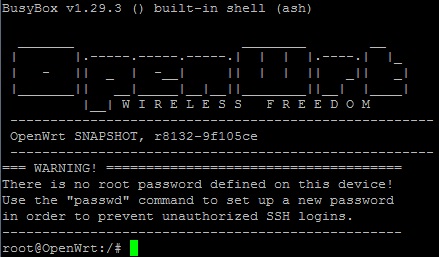
第一次运行系统时,系统会自动拓展TF卡上rootfs文件系统分区到最大可用空间:

请耐心等待文件系统扩展完成。
- SSH登录
板子的OpenWrt系统默认被配置为二级无线路由功能,其中eth0被配置为WAN功能,wlan0被配置为LAN功能。
板子的OpenWrt系统默认被配置为二级无线路由功能,其中eth0被配置为WAN功能,wlan0被配置为LAN功能。
如果您想通过SSH登录系统,那么启动系统前,请先用网线连接板子的千兆以太网口到一级路由器的LAN口,以便千兆以太网能通过DHCP获取到IP地址。
这里假设已经通过调试串口或者一级路由器确定板子的千兆以太网(eth0)的IP地址为192.168.1.163,执行下列命令可以通过SSH登录系统:
$ ssh root@192.168.1.163
系统默认设置root用户不需要密码就可以登录。
- Web登录
OpenWrt系统支持通过LuCI Web界面进行访问和配置,请参考<SSH登录>章节的设置启动系统,这里假设板子的千兆以太网的IP地址为192.168.1.163,在浏览器中输入该IP地址就可以登录OpenWrt-LuCI界面:
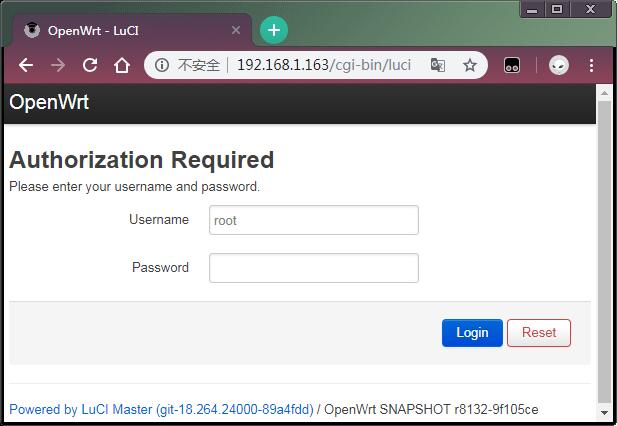
默认用户名为root,无需密码,所以直接点击"Login"按键即可登录。
8.3 手机连接开发板的无线WiFi热点
- 请注意给开发板安装好WiFi天线。
- 板子的OpenWrt系统默认被配置为二级无线路由功能,无线WiFi模块AP6212默认运行在AP 模式,默认的WiFi AP热点名称类似为“OpenWrt-10:d0:7a:de:3d:92”,没有密码,手机可以直接连接该热点然后访问互联网。
- 默认WiFi热点所在的网段为192.168.2.x,手机可以在浏览器中输入192.168.2.1以访问LuCI界面:
- 当手机等设备成功连接到开发板的WiFi热点后,在LuCI的Netwrok ---> Wireless界面里可以查看已成功连接的设备:
8.4 软件包管理
OpenWrt使用opkg工具来管理软件包,执行如下命令可以获取opkg的帮助信息:
$ opkg
Package Manipulation:
update Update list of available packages
upgrade <pkgs> Upgrade packages
install <pkgs> Install package(s)
configure <pkgs> Configure unpacked package(s)
remove <pkgs|regexp> Remove package(s)
flag <flag> <pkgs> Flag package(s)
<flag>=hold|noprune|user|ok|installed|unpacked (one per invocation)
Informational Commands:
list List available packages
list-installed List installed packages
list-upgradable List installed and upgradable packages
list-changed-conffiles List user modified configuration files
files <pkg> List files belonging to <pkg>
search <file|regexp> List package providing <file>
find <regexp> List packages whose name or description matches <regexp>
info [pkg|regexp] Display all info for <pkg>
status [pkg|regexp] Display all status for <pkg>
download <pkg> Download <pkg> to current directory
...上面只截取了部分帮助信息,请自行查阅完整的帮助信息,下面会描述几个常用的opkg命令。
- 更新可用软件包列表
第一次安装软件前,建议先更新可用软件包列表:
$ opkg update
- 查看可安装的软件包:
$ opkg list
本WiKi编写时,可安装的软件包共有3241个。
- 查看已安装的软件:
$ opkg list-installed
本WiKi编写时,已安装的软件包共有124个。
- 安装/删除软件:
$ opkg install <pkgs> $ opkg remove <pkgs>
- 查看已安装的软件包含什么文件:
$ opkg files <pkg>
- 安装LuCI中文语言包:
$ opkg install luci-i18n-base-zh-cn
- 查看当前系统中哪些配置文件被修改过:
$ opkg list-changed-conffiles
- 相关参考:
8.5 查看系统状态
- 命令行查看CPU温度和频率:
$ cpu_freq CPU0 online=1 temp=26581 governor=ondemand cur_freq=480000 CPU1 online=1 temp=26581 governor=ondemand cur_freq=480000 CPU2 online=1 temp=26581 governor=ondemand cur_freq=480000 CPU3 online=1 temp=26581 governor=ondemand cur_freq=480000
上述信息表示当前有4个CPU核心在线, 温度均约为26.5摄氏度, 运行的策略均为根据需求来决定运行频率, 当前的运行频率均为480MHz。
- OpenWrt-LuCI Web界面查看系统状态:
登录OpenWrt-LuCI界面后,点击顶部的 Statistics ---> Graphs,可以查看系统的各种软硬件状态信息(即statistics),例如:
1) 系统负载:
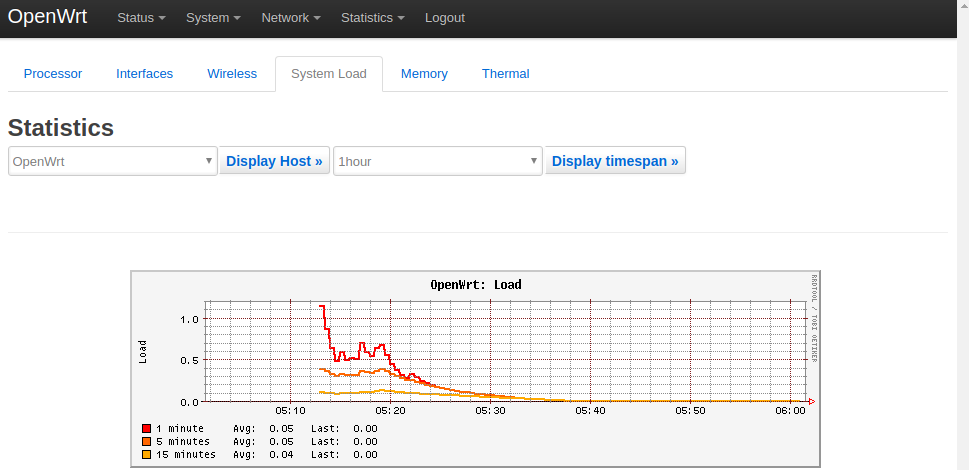
2) 内存:
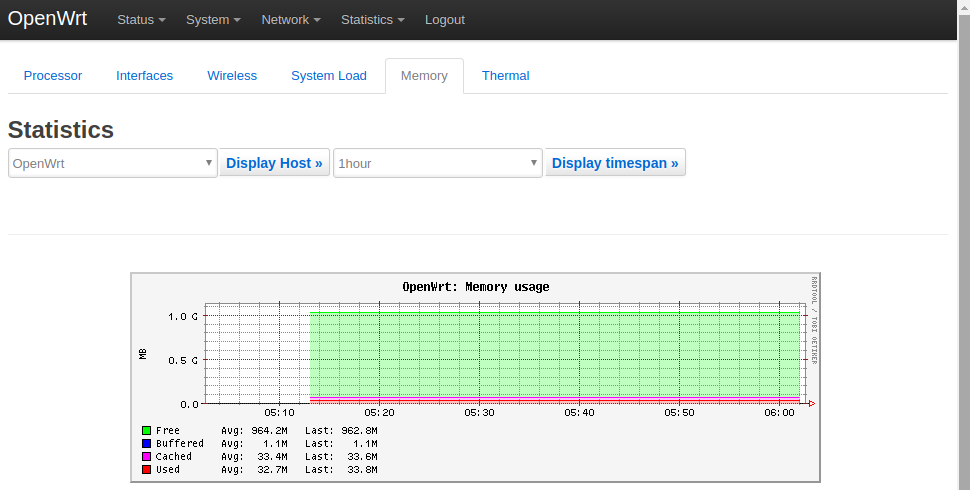
3) CPU温度:
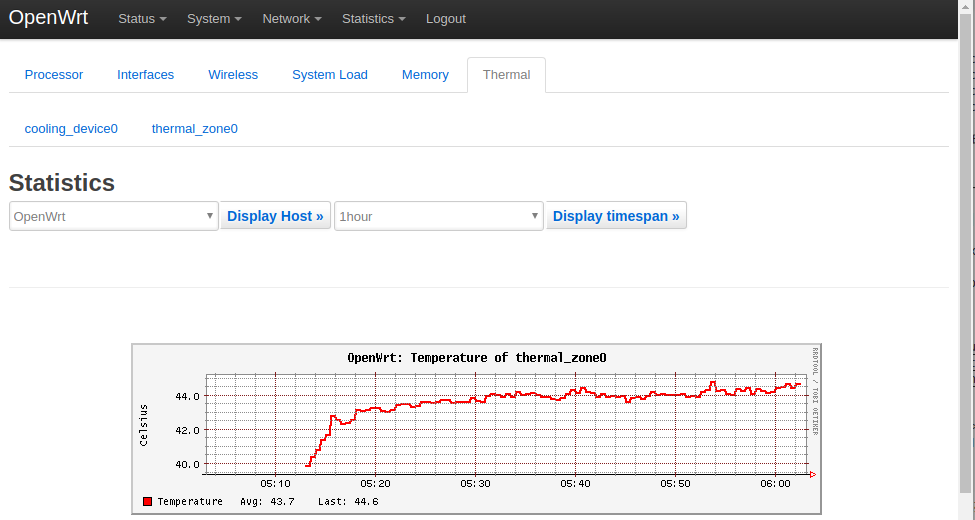
Statistics界面对应软件包luci-app-statistics,luci-app-statistics软件包用Collectd工具收集状态数据并且用RRDtool工具将数据渲染为图表。
你可以通过安装额外的collectd-mod-*软件包去使能更多的statistics.
所有的collectd-mod-*软件包对应同一个配置文件: /etc/config/luci_statistics。
8.6 查看Network->Interfaces的配置
- 登录OpenWrt-LuCI界面后,点击顶部的 Network ---> Interfaces ,可以查看当前有线网络接口的功能配置:
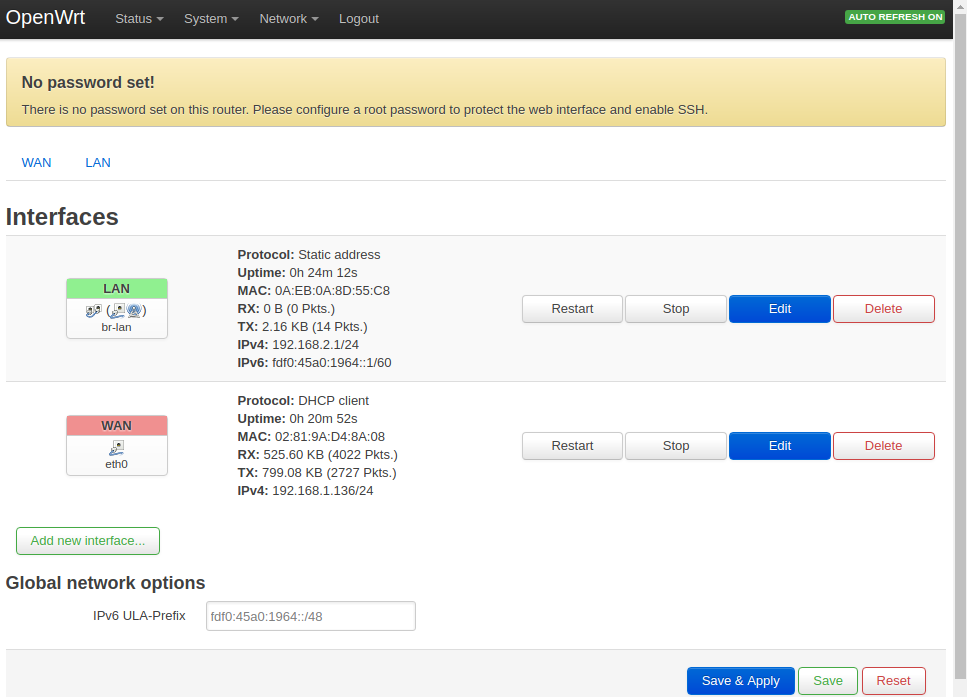
其中,千兆以太网eth0 被配置为WAN 功能,百兆以太网eth1 被配置为LAN 功能。
- 点击顶部的“WAN” 和“LAN” 可对WAN口和LAN口进行设置。
- Network->Interfaces界面的配置会保存在文件/etc/config/network中。
8.7 查看Netwrok->Wireless的配置
- 登录OpenWrt-LuCI界面后,点击顶部的 Network ---> Wireless,可以查看WiFi 热点的设置界面:
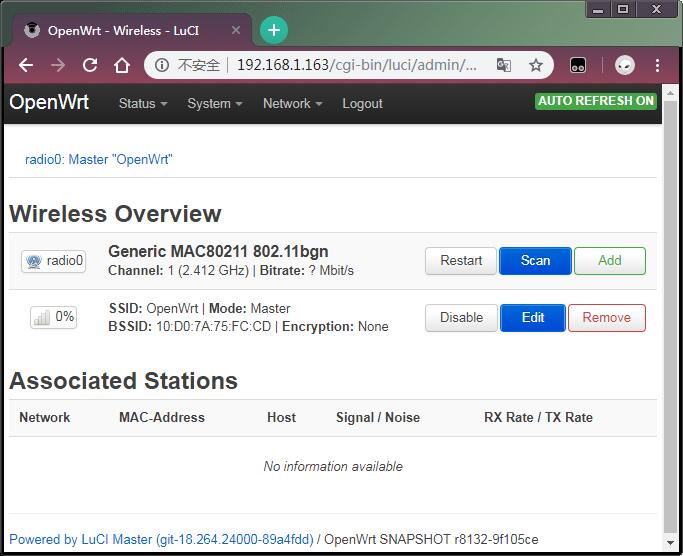
默认的WiFi AP热点名称类似为“OpenWrt-10:d0:7a:de:3d:92”,没有密码,手机可以直接连接该热点然后访问互联网。
- 点击“Edit” 按钮,更改Interface Configuration ---> General Setup ---> ESSID 可以更改WiFi热点的名字,点击Save & Apply 保存。
- 在Interface Configuration ---> Wireless Security 的 Encryption 可以设置WiFi 热点的加密方式,在Key 设置WiFi热点的密码,点击Save & Apply 保存。
- 在 Network ---> Wireless 页面的 Associated Stations 可以查看当前连接到WiFi 热点的设备。
- Network->Wireless界面的配置会保存在文件/etc/config/wireless中。
9 Build Linux System
9.1 Based on Linux-4.14 BSP
The NanoPi M1-Plus supports the Linux-4.14 kernel which is mainly maintained and supported by open source communities. FriendlyElec ported this kernel to the NanoPi M1-Plus.
Here is a reference link to more details about how to make image files for Allwinner H3 based on mainline U-boot and Linux-4.14 kernel:Building U-boot and Linux for H5/H3/H2+
9.2 Based on Linux-3.4 BSP
The Linux3.4 BSP is provided by Allwinner. FriendlyElec ported this to the NanoPi M1-Plus.
9.2.1 Preparations
Get lichee source:
$ git clone https://github.com/friendlyarm/h3_lichee.git lichee --depth 1
Note: "lichee" is the project name named by Allwinner for its CPU's source code which contains the source code of U-boot, Linux kernel and various scripts.
9.2.2 Install Cross Compiler
Visit this site download link, enter the "toolchain" directory, download the cross compiler "gcc-linaro-arm.tar.xz" and copy it to the "lichee/brandy/toochain/" directory.
9.2.3 Compile lichee Source Code
Compilation of the H3's BSP source code must be done under a PC running a 64-bit Linux.The following cases were tested on Ubuntu-14.04 LTS-64bit:
$ sudo apt-get install gawk git gnupg flex bison gperf build-essential \ zip curl libc6-dev libncurses5-dev:i386 x11proto-core-dev \ libx11-dev:i386 libreadline6-dev:i386 libgl1-mesa-glx:i386 \ libgl1-mesa-dev g++-multilib mingw32 tofrodos \ python-markdown libxml2-utils xsltproc zlib1g-dev:i386
Enter the lichee directory and run the following command to compile the whole package:
$ cd lichee/fa_tools $ ./build.sh -b nanopi-m1-plus -p linux -t all
After this compilation succeeds a u-boot, Linux kernel and kernel modules will be generated
Note: the lichee directory contains a cross-compiler we have setup. When you compile the source code it will automatically call this cross-compiler.
9.2.4 Compile U-boot
Note:you need to compile the whole lichee directory before you can compile U-boot individually.
You can run the following commands to compile U-boot:
$ cd lichee/fa_tools/ $ ./build.sh -b nanopi-m1-plus -p linux -t u-boot
The gen_script.sh script patches the U-boot with Allwinner features. A U-boot without these features cannot work.
Type the following command to update the U-boot on the MicroSD card:
$ cd lichee/fa_tools/ $ ./fuse.sh -d /dev/sdX -p linux -t u-boot
Note: you need to replace "/dev/sdx" with the device name in your system.
9.2.5 Compile Linux Kernel
Note:you need to compile the whole lichee directory before you can compile Linux kernel individually.
If you want to compile the Linux kernel run the following command:
$ cd lichee/fa_tools/ $ ./build.sh -b nanopi-m1-plus -p linux -t kernel
After the compilation is done a boot.img and its kernel modules will be generated under "linux-3.4/output".
9.2.6 Clean Source Code
$ cd lichee/fa_tools/ $ ./build.sh -b nanopi-m1-plus -p linux -t clean
10 Applications under Android
10.1 IR Controller(RC-100)
You can use FriendlyARM's IR controller(RC-100) to navigate the Android system.
Here is a list of the function keys on the RC-100 IR controller
Key Function POWER On/Off F1 Search F2 Open Browser F3 Enable/Disable Mouse UP Move Up DOWN Move Down LEFT Move Left RIGHT Move Right OK OK Volume- Turn Down Volume Mute Mute Volume+ Turn Up Volume SETTING Go to Setting Window HOME Go to Home Window BACK Go Back to the Previous Window
After Android is loaded for the first time you need to follow the prompts on Android's GUI to enter the main window and then press F3 to enable mouse and complete the setup process by navigating "up", "down", "left", "right" and "OK".
10.2 Play 4K Video
Visit this the test-video directory of this link download link and download the 4K video file: 4K-Chimei-inn-60mbps.mp4 and copy it to an SD card or USB drive.
Boot Android on your M1 Plus and insert this SD card or USB drive to it. After locate the 4K video file with ESFileExplorer click on and play it with Android's Gallery player.
In our test playing this 4K video file from a USB drive worked better.
11 Make Your Own Android
11.1 Preparations
- Compilation of the H3's BSP source code must be done under a PC running a 64-bit Linux.The following cases were tested on Ubuntu-14.04 LTS-64bit:
$ sudo apt-get install gawk git gnupg flex bison gperf build-essential \ zip curl libc6-dev libncurses5-dev:i386 x11proto-core-dev \ libx11-dev:i386 libreadline6-dev:i386 libgl1-mesa-glx:i386 \ libgl1-mesa-dev g++-multilib mingw32 tofrodos \ python-markdown libxml2-utils xsltproc zlib1g-dev:i386
- Packaging an Android image relies on the scripts in the lichee's source code. Therefore you need to clone lichee's source code:
$ git clone https://github.com/friendlyarm/h3_lichee.git lichee
Note:lichee is the name of the project in which Allwinner provides support for its CPUs. The lichee source code includes the source code of U-boot, Linux and various scripts. You cannot rename the "lichee" directory.
- Clone Android Source Code:
$ git clone https://gitlab.com/friendlyelec/h3_android-4.4 android
Since packaging an Android image relies on the scripts in the lichee's source code. Therefore you need to clone the Android source code under the same directory where lichee is located and name the cloned directory "android":
$ ls ./ android lichee
- Install Cross Compiler:
In order to compile the lichee source code you need to visit this site download link, enter the "toolchain" directory, download the cross compiler "gcc-linaro-arm.tar.xz" and copy it to the "lichee/brandy/toochain/" directory.
11.2 Compile Android
- Setup Environment
Run the following commands on a host PC running 64-bit Ubuntu-14.04 LTS-64bit:
$ sudo apt-get install bison g++-multilib git gperf libxml2-utils make python-networkx zip flex libncurses5-dev zlib1g-dev gawk minicom
For more details refer to:android_initializing。
- Install JDK
We used the JDK1.6.0_45. You can get it from Oracle: Oracle JDK . In our test we installed it in the /usr/lib/jvm/ directory.
- Compile System
$ cd lichee/fa_tools/ $ ./build.sh -b nanopi-m1-plus -p android -t all # compile lichee's source code and this will generate a kernel and drivers for Android. $ cd ../../android $ export PATH=/usr/lib/jvm/jdk1.6.0_45/bin:$PATH $ ./build.sh -b nanopi-m1-plus # compile android's source code and this will generate an Android image file.
After the above commands are finished an Android image "sun8iw7p1_android_nanopi-m1-plus_uart0.img" will be generated under the "lichee/tools/pack/" directory.
11.3 Clean Source Code
$ cd lichee/fa_tools/ $ ./build.sh -b nanopi-m1-plus -p android -t clean
12 Developer's Guide
- System Development
- System Configurations
- Hardware Access
13 3D Housing Printing Files
- NanoPi M1 Plus 3D housing printing files:[2]
14 Resources
- Schematic
- Dimensional Diagram
- Allwinner H3 datasheet Allwinner_H3_Datasheet_V1.2.pdf
- Matrix Modules & Wiki Sites:
- Button
- LED
- A/D Converter
- Relay
- 3-Axis Digital Accelerometer
- 3-Axis Digital Compass
- Temperature Sensor
- Temperature & Humidity Sensor
- Buzzer
- Joystick
- I2C(PCF8574)+LCD1602
- Sound Sensor
- Ultrasonic Ranger
- GPS
- Matrix - Compact Kit
- Fire Sensor
- CAM500A Camera
- BAll Rolling Switch
- 2'8 SPI Key TFT 2.8" SPI LCD
- IR Counter
- IR Receiver
- L298N Motor Driver
- MQ-2 Gas Sensor
- MQ-3 Gas Sensor
- One_Touch_Sensor
- _Photoresistor
- _Potentiometer
- Pressure & Temperature Sensor
- RGB LED
- RTC
- Rotary Encoder
- Soil Moisture Sensor
- Thermistor
- USB WiFi
- Water Sensor
15 Update Log
15.1 March-1-2017
- Released English Version
15.2 May-24-2017
- Added section 3: software features
15.3 June-4-2017
- Updated section 3: added OS features
15.4 June-13-2017
- Added section 7: working with UbuntuCore
15.5 July-8-2017
- Updated sections 6.4 & 6.9
15.6 Jan-30-2018
- Reorganized wiki
- Updated section 7.6
15.7 April-13-2018
- Added sections 6.6, 7.11, 7.16 and 7.17
15.8 August-1-2018
- Updated section 10
15.9 Dec-19-2018
- Updated section 8
